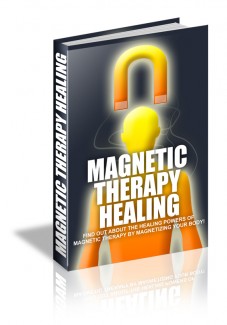 License Type: Master Resell Rights
License Type: Master Resell Rights  File Size: 2,067 KB
File Size: 2,067 KB File Type: ZIP
File Type: ZIP
 SKU: 54626
SKU: 54626  Shipping: Online Download
Shipping: Online Download
Ebook Sample Content Preview:
Chapter 4: How Magnets Help Pain
Synopsis
Pain is a social issue of enormous proportions. For instance, eighty percent of people have severe back pain onetime in their lives, forty million suffer from arthritic pain, and forty million have repeated headaches. Habitual pain alone costs the economic system nearly $100 billion yearly.
Painkilling drugs don't appear to be the answer. Their affectivity is limited, the body constructs tolerance, and side effects hospitalize over 76,000 individuals yearly.
As of the need, pain has been the most emphasized magnetic-therapy practical application. Numerous fields of study support its efficaciousness.
Pain Relief
A Trust in the healing power of magnets has been around since ancient Greece, extending to a $5 billion a year global industry that furnishes millions of worshipers with magnets for everything from arthritis to cancer to depression.
That's in spite of the fact that numerous scientific fields of study have been either inconclusive or not able to find evidence to support the claims of their healing energy. Till now.
Fresh research at the U of V demonstrates that there is at least a little truth to the oft-cited claim that magnets may step-up the flow of blood, therefore supplying more oxygen and nutrients to wounded tissue.
Research workers have demonstrated that a mild magnetic field may cause the littlest blood vessels in the body to enlarge or constrict, thus increasing the blood flow and conquering inflammation, a vital factor in the mending process.
Thus far, the findings are based on experimentations with rats, but the researchers hope to start human clinical trials in the near future, while that could prove to be a major challenge.
What sets this work aside from most research into the alleged curative effects of magnets is the fact that the research workers were able to measure their results by measuring the changes in the blood vessels to ascertain the affect on inflammation.
It's the beginning direct measurements that demonstrate the reduction in swelling. Their determinations don't lend credence to the wild claims of a lot of manufacturers of magnetic panaceas. Rather, their work was really precisely centered on the claim that magnets may increase the flow of blood.
The investigators utilized anesthetized rats for their work. The rats' paws were handled with inflammatory agents to imitate tissue damage, and a little magnet, approximately ten times more powerful than a common refrigerator magnet, was bound to their paws.
The swelling was cut back by approximately fifty percent, apparently because the magnetic field altered the diameter of the blood vessels. The magnet only had to stay in place for fifteen to thirty minutes. If the investigators waited till after the paw was amply inflamed, the magnet caused no effect.
If magnets work that well in mortal trials, the affect may be dramatic, as in a lot of cases reducing inflammation is crucial to a rapid recovery.
Let's suppose it takes you 4 or 5 days to recuperate from a given trauma and get back to work, or back on the playing field. If by forestalling the swelling you recuperate after 2 days, you've cut the curative time by a factor of 2. That's enormous savings worldwide in worker productivity and the caliber of life.
Naturally, like results may also be accomplished by implementing an ice pack and compression, but that's not all of the time convenient.
A magnet, of simply the correct power, may be carried with more ease and is always be available within moments of an injury. However at this point no one knows precisely the correct dosage, or in this case the essential magnetic force, to match up with which trauma.
One size will not work for everyone. It would require a much more potent magnet, for instance, to deal with a thigh muscle than a sprain in the little finger. And, frequently no one recognizes yet if it will work at all in human beings.
However researchers are optimistic based on a lot of years of experience in a comparatively narrow field. The really small blood vessels are in all the tissues in your body and that's where the action is. That's where oxygen gets handed over, and it's where waste material gets transferred from your tissues.
These little arterials may open and close as they've a layer of smooth muscle wound around them. They may expand their diameter, therefore handing over more flow to a given tissue, and they may decrease the diameter, simply like opening and closing a garden hose alters the flow of water.
If a magnetic field was held to the paws of the lab rats, the vessels that had been constricted, and the compressed vessels dilated, indicating that the magnetic field "brought on vessel relaxation in tissues with encumbered blood supply, finally increasing blood flow.
The mechanics isn't amply understood, but it seems that the magnetic field changes the flow of positively excited calcium ions that interact with the muscles around the little blood vessels, causing them to expand or compress.
Magnets are attractive to numerous people, and their utilization has been widespread for many centuries. Early trusters believed magnets may pull diseases and pain from the body, a belief that endures to this day.
Magnets have demonstrated to be a valuable tool in medicine for an extended assortment of uses. A number of researchers are formulating methods to utilize small magnets to draw chemotherapy-carrying magnetic
molecules into tumors and hold them there, therefore killing cancerous cells while saving nearby healthy cells.
And magnets are at the heart of one of innovative medicine's most useful processes, magnetic resonance imaging. This device presents physicians precise images of the total human body in astonishing detail.
- File Size:2,067 KB
- License: Master Resell Rights
- Category:Ebooks
- Tags:2015 Ebooks Master Resale Rights








